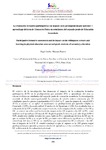La evaluación formativa participativa y su impacto en la predisposición por aprender y aprendizaje del área de Educación Física en estudiantes del segundo grado de Educación Secundaria

Use este enlace para citar
http://hdl.handle.net/2183/22760
A non ser que se indique outra cousa, a licenza do ítem descríbese como Atribución-NoComercial-SinDerivadas 3.0 España
Coleccións
Metadatos
Mostrar o rexistro completo do ítemTítulo
La evaluación formativa participativa y su impacto en la predisposición por aprender y aprendizaje del área de Educación Física en estudiantes del segundo grado de Educación SecundariaTítulo(s) alternativo(s)
Participative formative assessment and its impact on the willingness to learn and learning in physical education area second grade students of secondary educationAutor(es)
Data
2017Cita bibliográfica
Sportis, 2017, 3 (1):206-220 ISSN: 2386-8333
Resumo
[Resumen] El objetivo de la investigación fue demostrar el impacto de la evaluación formativa participativa (EFP) en la predisposición por aprender (PA) y aprendizaje del área de educación física en estudiantes del segundo grado de educación secundaria. La investigación responde al diseño cuasiexperimental. La muestra de estudio estuvo compuesta por 53 estudiantes para los grupos experimentales (GE) (A-C) y 51 para los grupos de control (GC) (F-G); a quienes se les aplicó el cuestionario de predisposición por aprender (Alpha de Cronbach = 0,95) y la escala ordinal (Correlación de Spearman = 1,00). Los resultados tras la aplicación de la EFP y tradicional respectivamente, en la comparación de medias de los GE y GC, se aprecia un valor significativamente mayor en los GE respecto a los GC en PA, como también en el aprendizaje del área de EF. Según la prueba T, la tc > tt, y el valor de p=0,000 < 0,05, siendo muy similar en todos los casos, tanto en PA y aprendizaje del área de EF; por lo que se rechazó la Ho y se aceptó la H1, por tanto existe diferencia significativa en la PA y aprendizaje del área de EF en los estudiantes que representan los GE en relación a los GC, tras el impacto de la EFP. Él estudió concluyó en que el impacto de la EFP genera mayor predisposición por aprender y mejores niveles de aprendizaje en los estudiantes en el área de EF, a diferencia de la evaluación tradicional. [Abstract] The aim of the research was to demonstrate the impact of participative formative assessment (PFA) in the willingness to learn (WL) and learning area physical education second grade students of secondary education. The research responds to the quasi-experimental design. The study sample consisted of 53 students for (A-C) experimental group (EG) and 51 for the control group (CG) (F-G); who they were administered the questionnaire willingness to learn (Cronbach's alpha = 0.95) and the ordinal scale (Spearman correlation = 1.00). The results following the implementation of PFA and traditional respectively, comparing averages of the EG and CG, a significantly higher in the EG respect to CG in WL, as well as learning area PE is appreciated. According to the T test, tc> tt, and the value of p = 0.000 <0.05, being very similar in all cases, both WL and PE learning area; so that Ho was rejected and H1 accepted, therefore there is no significant difference in the learning area WL and PE students representing EG in relation to CG, after the impact of PFA. The study concluded that the impact of PFA generates greater willingness to learn and better standards of student learning in the area of PE, unlike traditional assessment
Palabras chave
Evaluación formativa participativa
Predisposición por aprender
Aprendizaje
Educación física
Formative participative assessment
Willingness to learn
Learning
Physical education
Predisposición por aprender
Aprendizaje
Educación física
Formative participative assessment
Willingness to learn
Learning
Physical education
Dereitos
Atribución-NoComercial-SinDerivadas 3.0 España
ISSN
2386-8333






